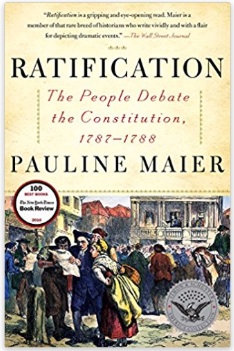
Three important books survey the U.S. Constitution’s ratification process for Virginia historians. “The Fate of the Revolution: Virginians Debate the Constitution” is a 204 page book which conveys the immediate contingency of a patriot-founder generation aroused and consumed by the question of nationhood and governance for their posterity. The issues resonate to this day.
“Ratification: The People Debate the Constitution, 1787-1788” is a 590 page book investigating the conventions of all thirteen states, with two chapters on the all important Virginia which bisected the United States North and South from the Atlantic in the east to its western border along the Mississippi River, with one in six of the U.S. population and one-fifth of its entire territory.
“The Federalist Papers” is a crucial primary document used in the state ratification conventions as a debate guide for advocates of the proposed new government. It was co-authored by Virginian James Madison “the father of the Constitution”, New Yorker Alexander Hamilton “the father of the U.S. Treasury” and John Jay, the first Chief Justice of the Supreme Court. Ever since the Court has used The Federalist Papers to determine the original intent of the Founding generation for the U.S. Constitution.
The Fate of the Revolution

The Fate of the Revolution: Virginians Debate the Constitution (2016) by Lorro Glover brings the two evenly matched sides in Virginia’s “Federal” or “Ratification” Convention to life. Led by James Madison for ratification versus Patrick Henry opposed, the two sides argued in public before packed galleries, influenced by previous public state conventions and sure to influence the following New York convention for a state that also completely dissected the United States territory east-west separating the New England “eastern” states that were one-third of the country.
Using transcripts, pamphlets, newspapers and letters, Glover describes the arguments that swayed eight votes for ratification against the clear opposition of constituents, and caused two delegates to vote for ratification against explicit instructions of mass meetings in their districts.
The Constitution was a dead letter until the debates breathed life into it, and the hopeful plan of the Federalists carried the day in a hopeful age. Nevertheless the experiment in a democratic republic was based on compromise. The opponents shunned violent opposition, and to get a majority, the proponents gave in to a qualified ratification requiring amendments in the First Congress that became the Bill of Rights. Buy “The Fate of the Revolution” at Amazon.com here.
Ratification: The People Debate

Ratification: the People Debate the Constitution, 1787-1788 (2011) by Pauline Maier considers the debates in state Conventions and “out of doors” in the press and at mass meetings that made up the process of ratifying the U.S. Constitution. She bases a chronological narrative story on the Documentary History of the Ratification of the Constitution, a scholarly collection of the State Historical Society of Wisconsin.
The political geography of each state is mapped, east and west, national and local, agricultural and merchant, aristocracy and democracy. This landscape is informed by anecdotes and brief sketches of the leading protagonists, for and against ratification. Ratification was not inevitable, success in establishing a new government was in doubt even after June 1788 with New Hampshire’s ninth ratification, because Virginia, New York, North Carolina and Rhode Island were still not committed.
The showdown was in Virginia, and Maier devotes two chapters to the developments in its convention. Patrick Henry, suspicious of a new central government that might be dominated by New Englanders with their many small states, opposed ratification. He was joined by George Mason, who insisted on amendments before ratification. James Madison, backed by the letter-writing George Washington at Mount Vernon, sought ratification without amendments. The ratification side in Virginia could not carry the day without the votes from those who insisted on amendment immediately after the new government began.
When the spot light moved to New York, a convention that had been two-to-one against ratification saw the question changed from the merits of the proposed constitution alone, to whether or not to join the new United States. The New Yorkers ratified, but again with recommended amendments. Federalists won but the critics did not lose. North Carolina and Rhode Island ratified in half the time it took thirteen states to ratify the Articles of Confederation. Buy “Ratification” on Amazon.com here.
The Complete Federalist and Anti-Federalist

The Complete Federalist and Anti-Federalist Papers (2014) is a convenient anthology of both the Federalist Papers by Hamilton, Madison and Jay, along with Anti-Federalist letters of New York’s “Cato” and “Brutus”, Pennsylvania’s “Centinel” and “Federal Farmer” who may have been Richard Henry Lee.
The Federalist Papers were widely circulated in eastern Virginia and at the Ratification Convention in Richmond. One of its authors was James Madison, the floor leader for ratification of the Constitution in Richmond. Richard Henry Lee was the proposer of independence in the Continental Congress, an Anti-Federalist in Virginia’s Ratification Convention, and Virginia’s first U.S. Senator (Anti-Administration) who advocated for amending the Constitution with the first ten amendments and more. Buy “The Complete Federalist and Anti-Federalist Papers” on Amazon.com here.
For a 12-step guide for building your personal Virginia History library, and reviews of additional selections, see the Book Club at TheVirginiaHistorian.com.

